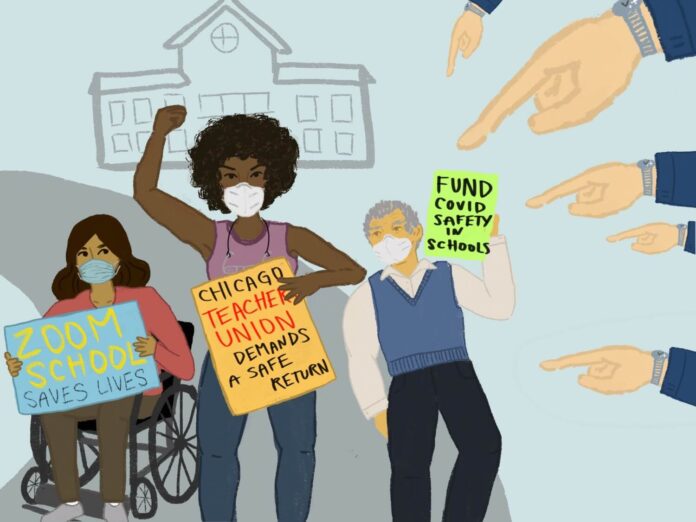Despite once being hailed for their sacrifices as essential workers, teachers and their unions have come under fire for demanding safer workplaces and temporary returns to remote schooling. With the larger trend of renewed union militancy, teachers have recently come to occupy the center of both national labor and COVID-19 issues. With some people accusing teachers of possibly costing the Democrats positions in Congress with the coming midterms, teachers’ unions have been the center targets of attacks from both conservatives and liberals, some of whom do not have children affected by remote learning.
Often cited is polling from the recent elections in Virginia. Glenn Youngkin, a Republican gubernatorial candidate who campaigned using culture war rhetoric, only won by two percentage points, yet media autopsies have implied that disruptions in schooling mobilized suburban white women to vote for him. It is rarely mentioned whether or not this mobilization was actually due to the Democrats’ inability to deliver on other promises in Virginia or nationally. Democratic turnout was lower compared to most elections and could be attributed to the performance of Virginia Democrats and the Biden Administration.
Much of this anti-union rhetoric often comes from media such as The Wall Street Journal, which recently published an opinion titled “Why the Chicago Teachers Union Always Gets What It Wants.” The article signaled its bad faith with the subtitle “[the Chicago Teachers Union (CTU)] can strike and ignore children because Illinois lawmakers give it extraordinary power.” And its authors, Ted Dabrowski and John Klingner, seem to have purposely excluded anything related to the safety of teachers and students, the spread of Omicron variant, the CTU’s listed demands or polling from either parents or teachers on the strike. To most, many of the CTU’s demands — such as a random weekly op-out testing program of 10 percent of all students and staff, contact tracing and a return to classes within the next week — would seem completely responsible and reasonable.
Instead, Dabrowski and Klingner complain about the union’s influence in Chicago politics and the relatively impressive benefits its members receive — even when union membership is its lowest in decades and the majority of Americans possess a positive image of unions.
While some amount of anti-union rhetoric is expected from conservative media, the actions against teachers’ unions have mostly come from high-profile Democrats. Chicago mayor Lori Lightfoot initially rejected the CTU’s demands and only agreed to provisions that the union’s vice president called, “the only modicum of safety that is available for anyone that steps foot in the Chicago Public Schools.” Lightfoot said after the deal, “No one is more frustrated than I am.” This is a very curious comment especially after Lightfoot’s city spent 60 percent ($480 million) of its Coronavirus Aid, Relief, and Economic Security Act (CARES) act money on Chicago’s police force, with $68 million not being spent at all!
How could the Democratic Party ever claim to represent working-class and minority interests when it blames its rushed reopenings on workers, many of whom are minorities?
Rather, the blame for the confusion around school reopenings ought to be placed squarely on those who promised speedy restoration of in-person schooling, particularly mayors of the cities with the largest school districts such as Chicago, LA, Washington D.C and New York — all of which have Democratic mayors and majorities in both their local and state legislative offices.
Regardless of the number of vaccinations among school workers, short staffing in open schools still causes disruptions that could have been avoided by re-opening more carefully. Instead of listening to demands for temporary remote learning, mayors, with the blessing of President Joe Biden, have irrationally pushed on for full reopenings. Teachers, whether unionized or not, have resisted through strikes and sickouts.
In January, there was a 13 percent positivity rate among Los Angeles Unified School District (LAUSD) employees and students. In New Mexico, the state government deployed the national guard to fill in for substitutes and dayworkers, instead of returning to online learning for a temporary period.
This isn’t even mentioning the low pay and constant staff shortages that public school districts experienced before the pandemic and in the face of already high nationwide voluntary resignations through the pandemic. Democrats will ultimately be alienating some of the most well-organized public sector unions and teachers in general. Education is already under threat from attacks from the right concerning book bannings and critical race theory hysteria. Material issues, such as overcrowded classrooms, overworked and underpaid teachers, remain ever present.
While the federal government has responded to most people’s needs through two stimulus checks and the addition of the Advance Child Tax Credit — which has already ended and is taxable — there must be a mobilization to keep in place the expansions to the welfare state and a demand for more. Unions have both the ability to fight for the needs of workers at individual workplaces and to mobilize their members to win political battles at local and national levels. Unions are often the only means by which working-class people can organize themselves in the workplace. They can be pillars of communities and states. Different levels of support, whether through volunteering, financial contributions or simply combating anti-union sentiments, mean an expansion of democracy.
![]()



































